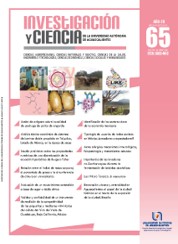Asma alérgica: mecanismos inmunológicos, fisiopatología y tratamientos actuales
DOI:
https://doi.org/10.33064/iycuaa2015653584Palabras clave:
incidencia de asma, fenotipos de asma, asma alérgica, citocinas TH2, , remodelación de las vías aéreas, tratamientosResumen
El asma es una enfermedad crónica de las vías aéreas que afecta a más de 300 millones de personas en todo el mundo, generando aproximadamente 250,000 muertes anuales. El asma alérgica es el fenotipo clínico más común de la enfermedad. En su etiología influyen múltiples factores genéticos y medioambientales y en su desarrollo participan muchas células inflamatorias como mastocitos, eosinófilos, neutrófilos, linfocitos T y células epiteliales. Los mediadores inflamatorios liberados por estas células generan y mantienen un estado de inflamación crónica que induce broncoconstricción, hiperreactividad bronquial y cambios estructurales en las vías aéreas. Descifrar y entender los mecanismos inmunológicos exactos involucrados en el desarrollo de asma alérgica es de crucial importancia para el desarrollo de nuevos tratamientos. El propósito de este trabajo es revisar la información más reciente sobre los elementos moleculares y celulares relacionados con el asma alérgica, así como su fisiopatología y los tratamientos actuales.
Descargas
Citas
• GALLI, S. J. y TSAI, M. IgE and mast cells in allergic disease. Nature Medicine, 18(5): 693-704, 2012.
• GRAINGE, C. L. et al. Effect of bronchoconstriction on airway remodeling in asthma. The New England Journal of Medicine, 2011(364): 2006-2015, 2011.
• GREENING, A. P. et al. Added salmeterol versus higher-dose corticosteroid in asthma patients with symptoms on existing inhaled corticosteroid. Lancet, 344(8917): 219-224, 1994.
• HARAGUCHI, M. et al. Morphometric analysis of bronchial cartilage in chronic obstructive pulmonary disease and bronchial asthma. American Journal of Respiratory and Critical Care Medicine, 159(3): 1005-1013, 1999.
• ISHMAEL, F. T. The inflammatory response in the pathogenesis of asthma. The Journal of the American Osteopathic Association, 111(11): 11-17, 2011.
• KARJALAINEN, E. M. et al. Airway inflammation and basement membrane tenascin in newly diagnosed atopic and nonatopic asthma. Respiratory Medicine, 97(9): 1045-1051, 2003.
• KIM, H. Y. et al. The many paths to asthma: phenotype shaped by innate and adaptive immunity. Nature Immunology, 11, 577-584, 2010.
• KLEIN WOLTERINK, R. G. J. et al. Pulmonary innate lymphoid cells are major producers of IL-5 and IL-13 in murine models of allergic asthma. European Journal of Immunology, 42(5): 1106-1116, 2012.
• KUDO, M. et al. Pathology of asthma. Frontiers in Microbiology, 2013(4): 1-16, 2013.
• LAMBRECHT, B. N. y HAMMAD, H. Asthma: the importance of dysregulated barrier immunity. European Journal of Immunology, 43(12): 3125-3137, 2013.
• LARCHÉ, M. Update on the current status of peptide immunotherapy. Journal of Allergy and Clinical Immunology, 119(4): 906-909, 2007.
• LEGG, J. P. et al. Type 1 and type 2 cytokine imbalance in acute respiratory syncytial virus bronchiolitis. American Journal of Respiratory and Critical Care Medicine, 168(6): 633-639, 2003.
• MIRANDA, C. et al. Distinguishing severe asthma phenotypes: role of age at onset and eosinophilic inflammation. Journal of Allergy and Clinical Immunology, 113(1): 101-108, 2004.
• NAVE, R. Clinical pharmacokinetic and pharmacodynamic profile of inhaled ciclesonide. Clinical Pharmacokinetics, 48(4): 243-252, 2009.
• NOBLE, P. B. et al. Relationship of airway narrowing, compliance, and cartilage in isolated bronchial segments. Journal of Applied Physiology, 92(3): 1119-1124, 2002.
• ORDOÑEZ, C. et al. Epithelial desquamation in asthma: artifact or pathology? American Journal Respiratory and Critical Care Medicine, 162(6): 2324-2329, 2000.
• PALMQVIST, M. et al. Inhaled dry-powder formoterol and salmeterol in asthmatic patients: onset of action, duration of effect and potency. European Respiratory Journal, 10(11): 2484-2489, 1997.
• PENNINO, D. et al. IL-22 suppresses IFN-γ–mediated lung inflammation in asthmatic patients. Journal of Allergy Clinical and Immunology, 131(2): 562-570, 2013.
• POLOSA, R. Critical appraisal of antileukotriene use in asthma management. Current Opinion in Pulmonary Medicine, 13(1): 24-30, 2007.
• RISMA, K. A. et al. V75R576 IL-4 Receptor α is associated with allergic asthma and enhanced IL-4 receptor function. The Journal of Immunology, 169(3): 1604-1610, 2002.
• ROCHE, W. et al. Subepithelial fibrosis in the bronchi of asthmatics. The Lancet, 333(8637): 520-524, 1989.
• SCHÄCKE, H. et al. Dissociation of transactivation from transrepression by a selective glucocorticoid receptor agonist leads to separation of therapeutic effects from side effects. Proceedings of the National Academy of Science of USA, 101(1): 227-232, 2004.
• SHARMA, S. et al. A novel (TG)n(GA)m repeat polymorphism 254 bp downstream of the mast cell chymase (CMA1) gene is associated with atopic asthma and total serum IgE levels. Journal of Human Genetics, 50(2005): 276-282, 2005.
• SOLER, M. et al. The anti-IgE antibody omalizumab reduces exacerbations and steroid requirement in allergic asthmatics. European Respiratory Journal, 18(2): 254-261, 2001.
• TAKHAR, P. et al. Class switch recombination to IgE in the bronchial mucosa of atopic and nonatopic patients with asthma. Journal of Allergy and Clinical Immunology, 119(1): 213-218, 2007.
• TANAKA, H. et al. Increased airway vascularity in newly diagnosed asthma using a high-magnification bronchovideoscope. American Journal of Respiratory and Critical Care Medicine, 168(12): 1495-1499, 2003.
• THOMSEN, S. F. et al. Estimates of asthma heritability in a large twin simple. Clinical and Experimental Allergy, 40(7): 1054-1061, 2010.
• WENZEL, S. E. Asthma phenotypes: the evolution from clinical to molecular approaches. Nature Medicine, 18(5): 716-725, 2012.
• YUKSELEN, A. y KENDIRLI, S. G. Role of immunotherapy in the treatment of allergic asthma. World Journal of Clinical Cases, 2(12): 859-865, 2014.
De páginas electrónicas
• GINA (GLOBAL INICIATIVE FOR ASTHMA). Recuperado el 5 de mayo de 2014, de http://www.ginasthma.org/
• INER (INSTITUTO NACIONAL DE ENFERMEDADES RESPIRATORIAS). Recuperado el 2 de abril de 2014, de http://www.iner.salud.gob.mx/
• OMS (ORGANIZACIÓN MUNDIAL DE LA SALUD). Recuperado el 1 de mayo de 2014, de http://www.who.int/es/
• SSA (SECRETARÍA DE SALUD) DIRECCIÓN GENERAL DE EPIDEMIOLOGÍA. Recuperado el 9 de junio de 2014, de http://www.epidemiologia.salud.gob.mx/
Descargas
Publicado
Cómo citar
Licencia
Derechos de autor 2015 Nuria Renata Roldán Bretón, Mariela Jiménez Vargas, Eva Salinas Miralles

Esta obra está bajo una licencia internacional Creative Commons Atribución-NoComercial-CompartirIgual 4.0.
Las obras publicadas en versión electrónica de la revista están bajo la licencia Creative Commons Atribución-NoComercial-CompartirIgual 4.0 Internacional (CC BY-NC-SA 4.0)









